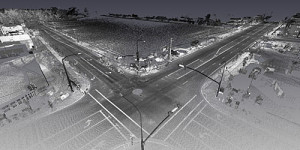 Do you remember the times we viewed and previewed everything in 2D? They practically built our childhoods. Then, animators gradually began venturing into the 3 dimensional world. The magic happened once a flat cartoon had transformed into a 3D model that can be seen on every angle.
Do you remember the times we viewed and previewed everything in 2D? They practically built our childhoods. Then, animators gradually began venturing into the 3 dimensional world. The magic happened once a flat cartoon had transformed into a 3D model that can be seen on every angle.
3D laser scanning is much the same concept. With the fast-growing economy and technological advances, our expectations grow bigger each year as a result. But the major issue is the time and effort. This is why 3D laser scanning is now becoming a staple of every project regardless of its scale.
How 3D laser scanning works
This high definition surveying (HDS) method or laser scanning is primarily responsible for capturing high quality and speed data of a building or an object that is difficult to see with the naked eye. These laser beams that are emitted in the scanning process grab millions of each and every pixel of an object with high accuracy. These are used to measure bridges, buildings, roadways, etc. These eye-safe beams then grab the accurate X, Y, and Z, values in minutes.
The recorded angles and distances are collected through returned laser light signals. Then a 3D site or an object presentation is created with these collected data that is called a point cloud. The point cloud can be easily manipulated by a computer and it also can use several scanned data and stitch them together seamlessly to create a whole structure.
The fun part is these 3D representations of the real structures can be easily scrutinized and evaluated for further developments.
But why 3D laser scanning?
3D laser scanning was originally used for industrial plant facility construction and maintenance. However, the relevance of this technology has made it to the building construction and building information modeling (BIM) as well.
3D laser scanning has much more to give and here are some of the crucial benefits of this technology.
- Measuring faster and saving time
3D scanners can capture data in larger environments within a matter of seconds. In fact, they can capture more or less 1,000,000 points in a second. This vastly supports projects that demand a quick turnaround. 3D laser scanning reduces man-hours enabling the projects to be more fruitful.
- No physical contact needed
3D laser scanners eliminate the issue of exposing valuable surveyors to hazardous environments. Sometimes, people can’t reach specific areas, and they can be reached with 3D laser scanners. Therefore, this is the perfect way of cutting down the costs of health and safety measures.
- Protects the objects that are being measured
3D laser scanning is a non-invasive method. For example, imagine there are sensitive objects or environments. They obviously need to be scanned with minimal physical interaction in order to preserve their original state.
The 3D laser scanning can safely put them in heritage or cultural sectors without damaging or displacing them.
- Supports construction planning
When there is a necessity to renovate or add new structures to a building, 3D scanners come in quite handy. The reason is, oftentimes the current construction or maintenance documents, drawings, etc. are missing or completely obsolete. If this is the case, 3D laser scanning can provide a thorough picture of the surrounding area to develop an on-point construction plan.
- Lossless details
The details you obtain from 3D scanning are thoroughly comprehensive and error-free. Even the tiniest details are recorded, allowing the surveyors to work on the project without having to re-visit the sites.
What’s more, 3D laser scanning lets the clients and the surveyors virtually visit the site with the above-mentioned point cloud walk-throughs. They can also have a 360 image on the project that they are working on.
- Cost-effective
All the above benefits come down to the conclusion of saving thousands of bucks for any construction project.
Thanks to 3D laser scanning, the projects are running fast, no costly measures needed, no physical re-visits needed and no harm is done to the scanned objects. Having top-notch details along with these benefits saves an unimaginable cost.
Do 3D laser scanners need great software?
The short answer is yes. Regardless of what your scanning process is, the software that is being used to create the point cloud can make a great difference to the end product. As a matter of fact, software should be the most crucial part of 3D laser scanning.
Software that is integrated with the scanning hardware allows you,
- To measure and export standard industry file types easily from the point cloud.
- To create a precise presentation combining various scans together.
- To have user-friendly tools to manipulate the 3D models.
Do 3D laser scanning hardware matter?
It is crucial to understand the performance level of the chosen 3D laser scanner largely affects the project’s final output. The following areas of the hardware should be on point to meet those respective requirements.
- Range
This can be the most important choice the buyer should make when they opt for a 3D laser scanner. They need to think about the range they expect to reach. Imagine you’re capturing something that is located hundreds of feet above. If you don’t plan on investing for lifts or scaffolding, you definitely should choose a long-range scanner.
- Speed
If the project requirement is to acquire high-resolution scans of an intricate environment, a slow scanner won’t do you any good. The whole point of having a 3D scanner is to make the surveyors’, engineers’, and other workers’ jobs easier.
- Accuracy
When a buyer invests in a 3D laser scanner, they should look for one that has pre-eminent accuracy. The accuracy of a scanner also depends on the temperature and humidity. Therefore, making sure to go for a scanner that can withstand harsh environmental conditions is mandatory. Imagine, putting off a valuable project just because you cannot use the 3D laser scanner in the heavy rain.
- Safety
Center for Devices and Radiological Health (CDRH) rates all the 3D laser scanners evaluating their safety levels for the eyes.
Class 1 is the highest rank a device can have that ensures no precautions are needed to operate it.
Summing up
3D laser scanning is a fine example of rapidly growing technology in the world. So, 3D laser scanners’ importance is a no brainer, as they save time, effort, money, and man-power all together by providing crystal clear depictions of a structure or an area.
Contact us here today for more information regarding your next project!








